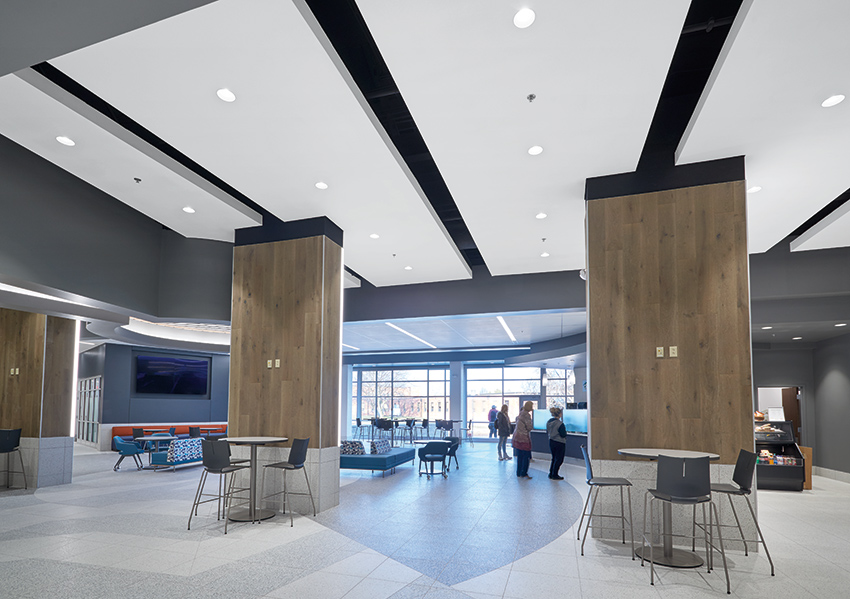How to Specify Seamless Acoustical Ceilings
 1 AIA LU/HSW; 1 IDCEC CEU/HSW; 1 GBCI CE Hour; 0.1 ICC CEU; 0.1 IACET CEU*; 1 AIBD P-CE; AAA 1 Structured Learning Hour; This course can be self-reported to the AANB, as per their CE Guidelines; AAPEI 1 Structured Learning Hour; This course can be self-reported to the AIBC, as per their CE Guidelines.; MAA 1 Structured Learning Hour; This course can be self-reported to the NLAA.; This course can be self-reported to the NSAA; NWTAA 1 Structured Learning Hour; OAA 1 Learning Hour; SAA 1 Hour of Core Learning
1 AIA LU/HSW; 1 IDCEC CEU/HSW; 1 GBCI CE Hour; 0.1 ICC CEU; 0.1 IACET CEU*; 1 AIBD P-CE; AAA 1 Structured Learning Hour; This course can be self-reported to the AANB, as per their CE Guidelines; AAPEI 1 Structured Learning Hour; This course can be self-reported to the AIBC, as per their CE Guidelines.; MAA 1 Structured Learning Hour; This course can be self-reported to the NLAA.; This course can be self-reported to the NSAA; NWTAA 1 Structured Learning Hour; OAA 1 Learning Hour; SAA 1 Hour of Core Learning
Learning Objectives:
- Discuss the challenge for architects to strike a balance between aesthetics, cost, and acoustic performance for the wellbeing of the occupant.
- Recognize the evolution and current options for smooth surface ceilings that improve acoustic performance.
- Compare performance, cost, and installation methods of seamless acoustical ceilings to ensure a healthy environment for occupants.
- List common misperceptions associated with seamless acoustical ceiling products.
This course is part of the Acoustics Academy
Most acoustical plaster has an NRC between 0.85 and 0.95, making it highly absorptive in comparison to other systems. Painted drywall, on the other hand, has an NRC of about 0.05, so it only absorbs about 5 percent of the sound that hits it, while reflecting back 95 percent. Seamless acoustical drywall alternatives feature a combination of high sound absorption and high sound blocking, all in one. That system controls “in-room” sound quality with an NRC of up to 0.80, which means it absorbs up to 80 percent of the sound that hits it. It controls “room-to-room" sound isolation with an extremely high CAC of up to 46, making it a “match” for STC 45 to STC 50 wall assemblies. This means it has the ability to support private conversation by not allowing sound to enter adjacent spaces.
It should be noted that all these acoustical systems require acoustically transparent finish since it is the board itself that absorbs the sound.
New single-layer acoustical ceiling systems can go on walls above 7 feet. With these wall assemblies, it’s important to consider STC which calculates the effectiveness of a product in reducing sound transmission between rooms. The higher the STC rating, the more effective that product is in reducing sound transmission. An acoustical drywall alternative ceiling system can improve the rating of interior stud and drywall partition systems by 6 points, which can make a big difference.
The seamless acoustic drywall alternative was developed to be flexible enough to provide solutions for a variety of spaces. It provides the clean, monolithic visual of drywall with excellent acoustical performance and sustainability attributes along with efficient installation in a wide variety of applications.
 Photo courtesy of Armstrong Ceiling and Wall Solutions
Photo courtesy of Armstrong Ceiling and Wall SolutionsLarge format, seamless acoustical ceiling clouds add visual impact and acoustical performance in large, open entry spaces, such as this area inside Vincennes University in Indiana.
Why Aesthetics Matter for the Occupant
Aesthetically pleasing architecture is not just about appreciation of beauty. A well-done design combines aesthetics and functionality in a way that can evoke positive feelings for occupants. These feelings enhance health and wellness, which is why the “Beauty and Design” feature of the WELL Building Standard is a requirement for all projects—aesthetic intention is integral to the quality of an occupant’s experience.
As with acoustics, aesthetics impact the way people live, work, learn, heal, and play. On one hand, if it’s inadequate or thoughtless, a building’s lack of a good aesthetic can make an occupant feel anxious or depressed. Yet when it’s working well, it can provide just the right space for a student in a university hall to begin to understand their passion for philosophy or mathematics. It can inspire workers to be present and solve problems in ways that lead to better innovations for a company. It also can be a way to signal the values of an organization to their employees or the public.
Health and Safety Profile
A high-quality acoustic drywall alternative meets the material and IEQ requirements of LEED, the WELL Building Standard, Fitwel, and Living Building Challenge. It has a Declare label showing it is free of Red List chemicals per the Living Building Challenge 4.0, a Health Product Declaration (HPD) that tells you what is in the product, and EPD (Environmental Product Declaration) detailing its carbon footprint. This product is listed in Mindful Materials and the Embodied Carbon in Construction Calculator (EC3) tool.
Sustainability Profile
As the built environment continues to grow globally, climate change calls for smarter, more sustainable approaches to building construction and material choices.
Twenty-eight percent of global emissions are from buildings in the form of operational carbon—the energy used to power, heat, and cool a building. A building’s operational carbon can be reduced through energy efficiency measures. Changes made by policymakers, architects, developers, and engineers have significantly advanced these measures. The remaining 11 percent of global carbon emissions attributed to building construction are generated from building materials and construction in the form of "embodied carbon" which can account for half of the total carbon footprint over the lifetime of a building.
For this reason, specifying systems with high sustainability profiles is imperative. When selecting a seamless acoustic ceiling system, it should meet stringent sustainability compliance standards, including LEED v4 and 4.1. The new acoustical drywall alternative consists of recycled materials, and it meets the Living Building Challenge, which is the most rigorous performance standard for buildings that “give more than they take” and are free of Red List chemicals. It should also provide a Health Product Declaration (HPD), which can tell you what is in the product, as well as being UL Greenguard Gold certified.
The idea is to support products that create a positive impact on the human and natural systems that interact with the building. Products that meet this standard are self-sufficient and sustainable, staying within the resource limits of their location. Manufacturers should be given preference when they provide documentation to support sustainable features.
Applications For The Acoustical Drywall Alternative
The seamless acoustical ceiling is becoming a common replacement for drywall. It is an alternative that can be used in almost any application where drywall is used and whenever acoustical performance is important.
Applications
A seamless acoustical ceiling system can be applied as an alternative to drywall in wall-to-wall, sloped, soffit, or cloud ceiling applications, as well as in wall applications above 7 feet. It is intended for spaces desiring a Level 4 equivalent drywall finish. Like Level 4 drywall, critical or low-angle light grazing across the ceiling can show imperfections. Ceilings are an excellent place to apply seamless acoustic systems, because the material can create better lit areas by enhancing daylight thanks to the 0.87 light reflectance value of the finish.
The acoustical drywall alternative can work well in wall-to-wall applications and can integrate with technologies that create horizontal and vertical separations in the walls for easy transition between walls and ceiling. It also can integrate with framing systems for easy soffit construction.
The gravitation toward open spaces in offices and other shared, flexible spaces are challenges when it comes to acoustics. One application that works well for the acoustical drywall alternative is ceiling clouds—a popular ceiling type that is made of ceiling panels that help absorb sound and control acoustics in these types of spaces. They are also aesthetically appealing, providing visual detail that can be arranged according to the design of the space.
Seamless acoustical ceiling clouds are suspended from the ceiling individually and can be designed in almost any shape, with or without integrated lighting. These clouds are ideal in exposed structure spaces because they can add acoustic and aesthetic appeal while absorbing sound on both the front and back surfaces if designed with acoustical infill material added to the back of the cloud.












